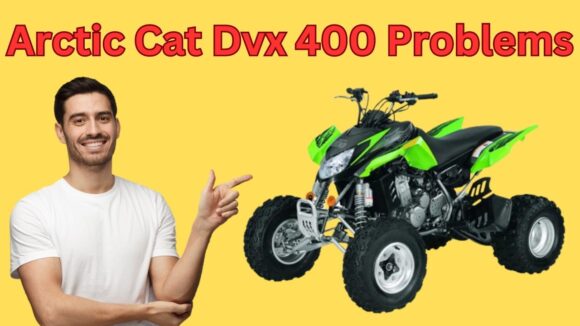In this article, we will discuss some of the most common Arctic Cat Dvx 400 problems as well as how to fix them quickly and easily.
Arctic Cat Dvx 400 Problems

1. Shifting Problem
Shifting problems with the Arctic Cat DVX 400 are common and can be caused by a variety of issues.
The first thing to check is the transmission fluid level, and filling it up to the appropriate levels (as specified in the owner’s manual) can help alleviate some shifting issues.
Also, the shift linkage rod may need adjusting if it is too tight or loose, as this can cause erratic shifting. Furthermore, the clutch may need to be adjusted or replaced if it has worn out over time.
Finally, the air in the lines can also lead to shifting difficulties – so bleeding and topping off the brake fluid can help resolve those issues.
2. Engine Noise Problem
Engine noise from an Arctic Cat DVX 400 is a common issue.
This sound is caused by the engine’s internal components wearing down over time, resulting in worn-out parts that don’t fit together properly.
This causes the engine to vibrate, creating a loud noise. More it, a lack of regular maintenance can cause the same issue to arise more quickly.
To address these issues, it is important to regularly change the oil and replace any worn-out parts.
More, having a professional mechanic inspect the engine on an annual basis can help identify potential issues before they become more serious and costly.
3. Running Problem
Running problems with Arctic Cat Dvx 400 can include difficulty starting the engine, stalling during operation, or running erratically.
These issues are usually caused by a lack of fuel, spark, or air. To diagnose the problem, it is important to check all of these systems.
Fuel system: Make sure there is enough fuel in the tank and that the fuel lines are free of blockages or debris.
Also, check the fuel filter for dirt buildup as this can cause a restriction in the flow of fuel to the engine.
Spark system: The spark plug should be checked for corrosion or damage and replaced if needed.
Check that there is a good connection between the spark plug wire and the spark plug.
Air System: Check that the air filter is clean and free of any blockages or debris.
If the air filter is clogged, it can prevent the engine from getting enough air and cause it to run poorly.
4. High Oil Consumption
High oil consumption in an Arctic Cat Dvx 400 is a common problem that many owners experience.
This issue is usually caused by worn-out piston rings, clogged or restricted oil passages, leaking valves, or an incorrect amount of oil in the crankcase.
Worn piston rings will allow more oil to enter the combustion chamber and burn off, resulting in high oil consumption.
Clogged or restricted oil passages can also prevent the proper amount of lubricant from reaching vital engine components, leading to higher oil consumption.
Changing valves may also allow more oil to enter the combustion chamber and burn off.
5. Overheating Issues
Overheating issues on Arctic Cat Dvx 400 ATVs can be caused by a variety of factors, including inadequate airflow to the engine, a clogged or dirty radiator, low coolant levels, a faulty thermostat, a malfunctioning cooling fan, worn-out spark plugs, or even a damaged engine component.
It is important to identify and address the source of these overheating issues as soon as possible. If left unchecked, they can cause serious engine damage or even catastrophic failure.
To prevent overheating, perform regular maintenance on your ATV and keep an eye out for any warning signs such as a hot-running engine or rising coolant temperatures.
Moreover, consider upgrading to a larger radiator or installing an auxiliary fan to ensure proper airflow through the engine.
6. Clutch issues
Clutch issues are common in Arctic Cat Dvx 400 vehicles, largely because they feature manual clutches. Clutch issues can range from a slipping clutch to the inability to engage gears.
The most common cause of this issue is worn-out clutch components, such as the clutch plates and springs.
If the issue persists, it may be necessary to replace these components for the proper functioning of the clutch system.
7. Poor Suspension
Poor suspension is a major problem for Arctic Cat Dvx 400s.
The main issue is that the shocks and other components of the suspension system have been known to wear out prematurely, resulting in a rough ride and poor handling.
In addition, the stock tires are too soft for many riding conditions and can also contribute to poor suspension performance.
If you are experiencing problems with your Dvx 400’s suspension, consider upgrading the shocks and tires to more robust components.
This can help improve the performance of your suspension and make riding a smoother, safer experience.
And, be sure to get regular suspension maintenance to help prolong the life of your shocks and other components.
Technical specifications of the Arctic Cat DVX 400:
| Specification | Arctic Cat DVX 400 |
|---|---|
| Engine Type | Single-cylinder, 4-stroke |
| Displacement | 398 cc |
| Bore x Stroke | 90 mm x 62.6 mm |
| Cooling System | Liquid-cooled |
| Fuel System | Keihin CVK 36mm carburetor |
| Starting System | Electric starter with recoil backup |
| Transmission | 5-speed manual with reverse |
| Drive System | 2WD (Rear-wheel drive) |
| Suspension (Front) | Independent double wishbone |
| Suspension (Rear) | Swingarm |
| Front Brakes | Dual hydraulic disc |
| Rear Brakes | Hydraulic disc |
| Front Tires | AT 22 x 7-10 |
| Rear Tires | AT 20 x 10-9 |
| Length | 72.2 inches (183.4 cm) |
| Width | 45.9 inches (116.6 cm) |
| Height | 44.1 inches (112 cm) |
| Seat Height | 31.1 inches (79 cm) |
| Ground Clearance | 10.8 inches (27.4 cm) |
| Wheelbase | 49.5 inches (125.7 cm) |
| Fuel Capacity | 3.3 gallons (12.5 liters) |
| Dry Weight | 375 lbs (170 kg) |
| Colors Available | Lime Green, Team Arctic Green, Red/Black |
| Warranty | 6 months limited warranty |
Conclusion
We hope this article has provided enough information for you to identify and solve any potential problems your ATV may have in the future.
If ever you run into an issue that requires professional help or advice, do not hesitate to contact us – our team of experts will be more than happy to assist in getting your ATV back up and running again as soon as possible!
FAQs
Who makes the DVX 400 engine?
The DVX 400 engine is manufactured by Suzuki Motor Corporation, a Japanese multinational corporation.
The engine has been used in Arctic Cat ATVs since 2004 and features an electric start, 4-valve cylinder head, and SOHC design.
It also offers high performance with its lightweight construction and low vibration due to rubber-mounted components.
What is the top speed of Arctic Cat DVX?
The top speed of Arctic Cat DVX 400 is approximately 60 mph (97 km/h).
However, the actual speed may vary depending on the terrain, the rider’s weight, and other factors.
What is an Arctic Cat 400 DVX?
The Arctic Cat 400 DVX is an all-terrain vehicle (ATV) manufactured by Arctic Cat.
It has a four-stroke engine with forward and reverse transmission, adjustable suspension, and offers plenty of power for riders to tackle any terrain.
It is designed for young adult riders who are looking for more performance than junior ATVs provide.
What is the top speed of a 2013 Arctic Cat DVX 90?
The 2013 Arctic Cat DVX 90 has a top speed of approximately 45-50 miles per hour (MPH) depending on the weight of the rider and terrain.
Arctic Cat Prowler 700 Xtx Problems
Arctic Cat Wildcat 700 Problem
Polaris Sportsman 600 Problems


